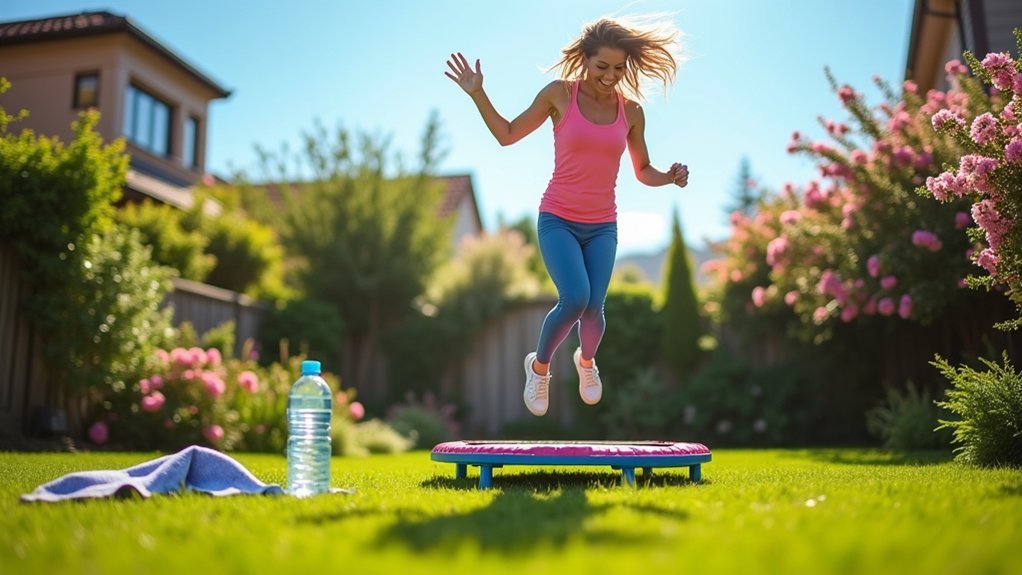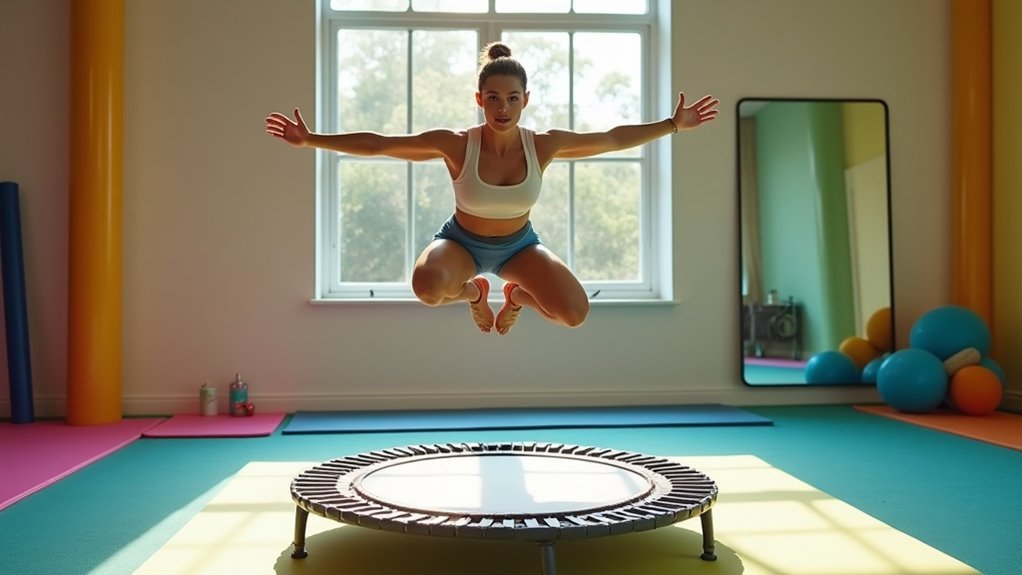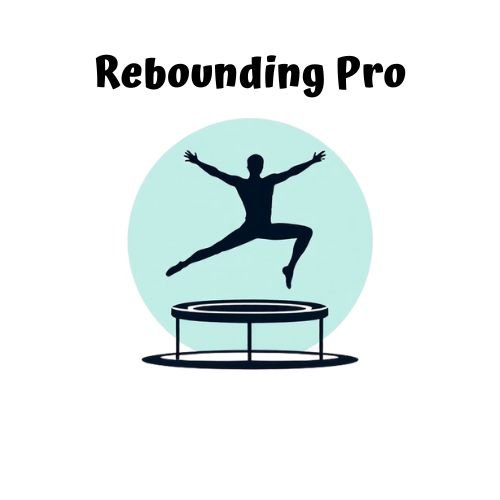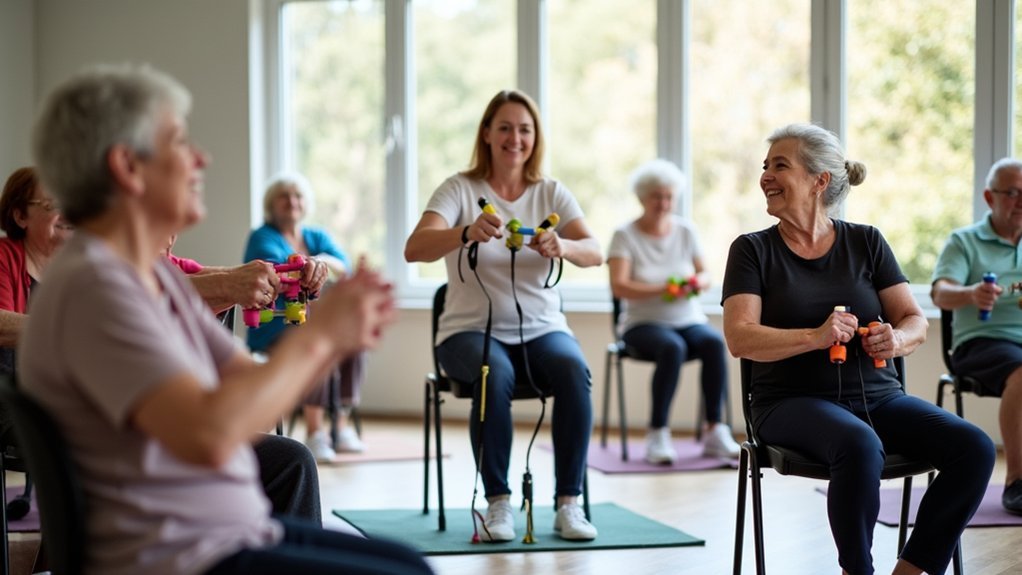Mini trampolines offer a joint-friendly way to get fit fast with 80% less impact than running. Start with a 90-second warm-up, then try basic bounces, scissors, and side-to-side jumps for 15 minutes. Keep your core engaged, knees slightly bent, and maintain proper posture to prevent injury. Track your progress with fitness apps and aim for 3 weekly sessions as a beginner. The following guide will transform your rebounding journey from novice to pro.
Why Mini Trampolines Are Perfect for Beginners

While many fitness enthusiasts turn to high-impact activities for results, mini trampolines offer an ideal starting point for beginners seeking effective exercise without unnecessary strain.
These rebounders absorb over 80% of impact, protecting your joints from the trauma typically associated with running or hard-surface workouts.
You’ll enjoy longer, more comfortable exercise sessions with reduced fatigue, making it easier to stick with your fitness routine.
NASA research confirms that trampoline exercise distributes G-forces more evenly throughout your body, reducing pressure on specific areas. This makes mini trampolines particularly suitable if you have joint pain or limited mobility.
The gentle bouncing motion provides cardiovascular benefits comparable to running but feels easier, allowing you to build fitness confidence while still burning significant calories and strengthening multiple muscle groups simultaneously. A single session of trampoline exercise delivers an effective aerobic workout that engages large muscle groups throughout your body.
Essential Equipment for Your Rebounding Journey
Starting your rebounding journey requires a suitable mini trampoline with the right frame size and weight capacity for your needs. Most quality rebounders range from 36 to 50 inches in diameter, with 40 to 44 inches being the ideal size for most workout routines.
A stability bar provides essential balance support while you’re learning new movements and building confidence in your routine.
Safety mats offer padding over springs and create a non-slip surface, reducing injury risk and maximizing your workout effectiveness.
Mini Trampolines Explained
Mini trampolines, also known as rebounders, serve as the foundation for effective trampoline workouts with their compact yet powerful design.
Typically constructed with powder-coated steel frames and polypropylene mats, these portable fitness tools support weights between 220-270 pounds while remaining easy to disassemble and transport.
You’ll find two main spring systems: traditional metal springs or bungee cords that provide a gentler bounce.
Safety features include PVC padding and spring covers to prevent injuries during your workouts. Many models offer adjustable angles for varied exercise options.
The benefits are substantial—you can burn up to 1,200 calories hourly with intense rebounding while improving cardiovascular health.
Their space-efficient design (usually under 50 inches in diameter) makes them perfect for both indoor and outdoor use, regardless of your living situation. Premium models like the ACON Freestyle offer five adjustable angles from 0° to 20° to customize your workout intensity.
Stability Bar Benefits
A stability bar transforms your mini trampoline into a thorough workout station for users at all confidence levels. If you’re recovering from injury, have balance concerns, or are simply new to rebounding, this accessory provides essential support while you build confidence. While beneficial for certain populations, stability bars can restrict movement and negatively impact your overall posture during high-energy rebounding sessions.
| Who Benefits | How It Helps |
|---|---|
| Older adults | Reduces fall risk during balance training |
| Children | Provides stability for developing coordination |
| Rehabilitation patients | Enables partial weight-bearing exercise |
| Beginners | Minimizes fear while building confidence |
| Special needs individuals | Offers support for balance-intensive movements |
While the bar provides safety advantages, it’s best used as a temporary aid. As you progress, gradually reduce your reliance on it to maximize core engagement and improve posture. Consider shifting to hands-free rebounding once you’ve developed adequate proprioceptive skills.
Safety Mats Matter
Protection begins at the edges of your trampoline with properly installed safety mats. These critical cushioning surfaces prevent common injuries by absorbing impact when you accidentally fall off the jumping surface.
Quality mats feature 1-inch thick closed-cell polyethylene foam covered with UV-resistant vinyl that withstands outdoor exposure. Ascertain your mats completely cover all frames and springs—particularly dangerous impact points that cause fractures and dislocations.
Always check that your safety mats properly fit your trampoline model to prevent hazardous gaps where limbs could get caught. Secure them firmly with the provided straps and buckles before each workout session. For young children especially, proper safety equipment like mats should be paired with constant adult supervision to minimize accident risks.
Don’t use safety mats as seats or steps, as this damages their protective qualities. Inspect them regularly and replace immediately if you notice wear, affirming your rebounding journey remains safe and effective.
The Science Behind Trampoline Fitness Benefits
Beyond just being fun, trampoline workouts offer remarkable physiological benefits supported by extensive scientific research. Your body gets more bang for its buck—trampoline exercises burn more calories in less time than traditional cardio while absorbing 80% of joint impact.
You’ll strengthen multiple muscle groups simultaneously as you bounce, particularly enhancing lower limb and core strength. Trampolining effectively builds strength by engaging your abs, glutes, legs, and back muscles during each jump.
Your cardiovascular system responds dramatically, with improved VO2 max and greater work capacity at lower perceived exertion levels.
Bounce your way to a stronger heart with less effort—trampoline workouts boost cardiovascular performance while feeling easier than traditional exercise.
The unique bouncing motion stimulates your lymphatic system, flushing toxins and reducing inflammation.
Meanwhile, your bones benefit from increased mineral density without the harsh impact of pavement running.
For older adults, balance improvements reduce fall risk by approximately 35%, making trampolining a scientifically sound fitness choice regardless of your age.
Proper Form and Technique for Safe Bouncing

Mastering proper form on your mini-trampoline starts with your feet positioned shoulder-width apart and weight distributed evenly through your heels and toes.
Keep your core engaged with a slight abdominal “scoop” while maintaining a neutral spine and relaxed shoulders to protect your back during bounces.
When landing, always bend your knees slightly and press through your heels rather than your toes to absorb impact safely and maximize muscle engagement. Focus on keeping your jumps low and controlled to reduce the risk of injuries while still getting an effective workout.
Feet and Core Positioning
Proper foot and core positioning forms the foundation of safe and effective trampoline workouts. Stand with your feet shoulder-width apart, ensuring even weight distribution to prevent ankle strain. Keep your feet aligned from right to left, and practice rolling from heel to toe with each bounce.
Engage your core muscles throughout your session to maintain stability and protect your spine. Keep your posture straight with slightly bent knees and your pelvis in a neutral position. Breathe naturally to support your balance and core engagement. Aim for subtle hip hinge when bouncing to optimize core activation and maintain proper alignment.
Focus your eyes forward while keeping your neck relaxed and aligned with your spine. This visual focus helps maintain proper form while your engaged core provides the stability you’ll need.
Remember that controlled movements with proper body alignment will maximize results while preventing injuries.
Mastering Safe Landing
Safe landing technique is the cornerstone of effective trampoline workouts, building directly on the foundation of proper foot and core positioning.
Keep your knees slightly bent at all times to absorb impact and prevent joint strain. As you land, roll through your foot from ball to heel for smooth shock absorption.
Ensure your knees align with your toes—never let them collapse inward or lock out. Land softly with controlled bounces rather than hard impacts, distributing weight evenly across your feet positioned shoulder-width apart.
Maintain a neutral spine with shoulders rolled back and core engaged during each bounce. Start with gentle, low-impact movements before progressing to higher jumps. Press down through heels to activate your core muscles and maintain balance during each movement.
This stamping motion—pressing down into the trampoline surface—creates stability and protects your joints through proper alignment.
Your First 15-Minute Beginner Workout Routine
A well-structured 15-minute trampoline workout can transform your fitness journey without overwhelming your body.
Start with a 90-second warm-up of gentle bouncing and alignment awareness before moving into the main exercises, each performed for 1-2 minutes.
- Basic Bounce – Stand with feet wider than hips in a slight squat position, focusing on pressing down into the mat rather than jumping high.
- Scissors and Side-to-Side Jumps – Alternate feet positions while keeping your core engaged and knees slightly bent. Remember that maintaining core engagement is essential throughout all movements to maximize benefits and protect your spine.
- Tempo and Open Runs – Simulate running in place with varying speeds to build cardio endurance.
Cool down by gently rocking while lying on the trampoline, hugging your knees to your chest to ease lower back tension.
5 Core-Strengthening Rebounding Exercises

Your core muscles work overtime during trampoline exercises, stabilizing your body with each bounce for better balance and posture.
Start with gentle twists while maintaining small, controlled jumps to engage your obliques and strengthen your entire midsection.
For deeper abdominal engagement, try bringing your knees toward your chest during bounces, which activates multiple core muscle groups simultaneously. The trampoline’s unique surface provides a fun alternative to traditional core workouts while still effectively building strength.
Engaging Abdominals While Bouncing
While many people focus only on the cardio benefits of rebounding, engaging your abdominals properly during trampoline exercises transforms a simple bouncing session into an extensive core workout.
Your core includes multiple muscle groups from your diaphragm to your pelvic floor, all of which can be effectively targeted through specific movements on the trampoline.
To maximize results, consider incorporating a rhythm of 40 seconds jumping followed by transitioning directly into core exercises with minimal rest between movements.
- Tuck jumps – Jump high and pull your knees toward your chest while wrapping your arms around them to intensely engage your rectus abdominis.
- Plank holds – Position yourself in a plank on the trampoline surface for deep core stabilization (the unstable surface increases difficulty).
- Seated V-ups – Sit on the trampoline, then lift both legs and upper body simultaneously to form a V shape.
Stabilizing Moves For Balance
Balance represents a cornerstone of effective rebounding workouts, extending beyond the abdominal exercises we’ve just covered. Your trampoline provides an unstable surface that naturally intensifies core engagement through constant microadjustments.
Start with modified side planks using the trampoline edge for support. Hold for 15-30 seconds while focusing on drawing your navel toward your spine.
Next, try single-leg balance drills—stand on one foot while gently bouncing, engaging your core to maintain stability. Consider incorporating 40-second intervals with 15-second transitions between balance exercises to optimize your workout flow and maintain momentum.
For a challenge, incorporate eyes-closed bouncing to remove visual cues and force deeper proprioceptive engagement.
As you progress, add controlled side-to-side movements and slow-motion rebounds with deliberate pauses. These exercises train your body’s stabilization systems while improving balance coordination that transfers to everyday movements.
Controlled Twists For Obliques
Targeting your obliques effectively requires controlled twisting movements on the trampoline that challenge your core in multiple planes of motion.
Keep your shoulders square while twisting your lower body to maximize the activation of both internal and external obliques. For best results, maintain slightly bent knees with feet wider than hip-width for stability. Finding joy in these exercises can help combat feelings when everything goes wrong during your day.
- Basic Twist Bounce – Alternate twisting your lower body left and right while bouncing, adding opposite arm swings for enhanced coordination.
- Surf Twist – Jump and rotate your lower body to one side while keeping shoulders forward, engaging deep core stabilizers.
- Knee Pull Twist – Lift one knee toward midline while balancing on the opposite leg, combining rotation with balance challenges.
Aim for 20-30 repetitions or 30-second intervals to build core endurance while enjoying cardiovascular benefits.
Progressing Your Trampoline Fitness Level
Once you’ve mastered the basics of trampoline exercise, you’ll want to strategically advance your workouts to continue seeing results.
Start by gradually increasing your jump height and adding dynamic arm movements to engage your upper body while boosting cardio intensity.
Elevate your trampoline routine by reaching higher and engaging your arms for a full-body cardio challenge.
Incorporate single-leg bounces and balance drills to strengthen your core stability. These exercises engage multiple muscle groups simultaneously, making trampolining an efficient full-body workout. As you gain confidence, try lateral movements like side-to-side jumps and rotational exercises such as 180-degree turns to challenge different muscle groups.
Structure your progression according to your fitness level: beginners should focus on 3 weekly sessions of basic bounces, while intermediates can split workouts between upper and lower body.
Advanced bouncers can implement 6-day training cycles with higher intensity exercises.
Always maintain proper form—soft knees and engaged core—to prevent injury as you advance.
Low-Impact Cardio Benefits for Joint Health
While traditional high-impact workouts can strain your joints, trampoline exercises offer a superior alternative for cardiovascular fitness. The springy surface absorbs up to 80% of the impact, greatly reducing stress on your ankles, knees, and hips while still providing excellent heart and lung benefits.
- Your joints experience minimal compression during bouncing, making trampolining ideal if you have arthritis or are recovering from injuries.
- Regular sessions strengthen the muscles surrounding your joints, enhancing stability and support for everyday movements.
- You’ll enjoy improved circulation that reduces stiffness and promotes natural joint lubrication, keeping you mobile and pain-free.
Unlike running on pavement, you’ll build cardiovascular endurance without the joint wear and tear, allowing for more consistent workouts and faster progress. Professional guidance is available to ensure you perform trampoline exercises with proper progression for maximum safety and effectiveness.
Balancing Exercises to Improve Stability
Because balance forms the foundation of all movement, trampoline workouts offer unique advantages for developing stability that regular floor exercises can’t match. The unstable surface naturally engages your core and stabilizer muscles, enhancing proprioception and reducing fall risk. Research indicates seniors who practice rebounding exercises experience a 35% improvement in overall balance capabilities.
| Exercise | Benefits |
|---|---|
| Single-leg stands | Improves unilateral balance and ankle stability |
| Heel raises | Strengthens calves and enhances postural control |
| Side-to-side steps | Develops lateral stability and weight transfer |
| Knee lifts & leg kicks | Engages core while challenging dynamic balance |
| Marching in place | Activates coordination with progressive difficulty |
Try holding each position for 10-30 seconds, using your arms overhead or to the sides for added challenge. Remember to engage your core throughout each movement, gradually increasing duration as your stability improves.
Incorporating Arm Movements for Full-Body Training
Transforming your trampoline workout from a lower-body focus to a full-body experience requires just one simple addition: arm movements.
By coordinating your arm actions with your bounces, you’ll boost cardiovascular intensity, increase calorie burn, and enhance lymphatic flow throughout your body.
Start with these beginner-friendly arm movements:
- Basic arm swings – Move your arms naturally forward and backward while bouncing to establish rhythm without fatigue.
- Jumping jack arms – Raise your arms above your head while jumping to engage shoulders and upper body.
- Monster jumps with arm openings – Open and close your arms while bouncing to improve circulation and activate multiple muscle groups.
Begin slowly to master coordination before adding speed or light weights (1-3 lbs) for increased resistance and upper body toning. Maintaining a proud chest position throughout your movements will help ensure proper form and maximize the effectiveness of your upper body workout.
Common Mistakes to Avoid on Your Rebounder
Even experienced athletes can make form mistakes that compromise both safety and results when exercising on a rebounder. Recognizing and correcting these errors will greatly enhance your workout efficiency and prevent potential injuries.
| Mistake | Correction |
|---|---|
| Jumping up instead of down | Focus on pressing down into the mat to engage core muscles properly |
| Bouncing on toes only | Distribute weight evenly through entire foot; engage heels |
| Leaning too far forward | Maintain slight hip hinge with shoulders rolled back |
| Locking knees | Keep a micro-bend in knees to absorb impact |
Remember to avoid high bounces that strain your pelvic floor. Instead, opt for controlled, low-impact movements with proper core engagement. Bracing your core during rebounding is essential to prevent lower back pain and maintain proper posture throughout your workout. Keep your hip flexors relaxed and make sure your knees track over your toes when landing to maintain stability.
Tracking Your Progress and Setting Goals
Now that you’ve mastered proper form, tracking your trampoline workout progress becomes the next step in your fitness journey.
Leverage technology by pairing your smartwatch or fitness tracker with your rebounding routine to monitor heart rate and analyze your movements through accelerometer data.
- Start with a baseline – Record your initial workout duration, intensity level, and how you feel afterward to measure improvements over time.
- Set realistic milestones – Begin with short 10-minute sessions three times weekly, gradually increasing duration and intensity as your stamina builds.
- Use fitness apps – Take advantage of specialized trampoline workout apps or create custom exercise profiles in your fitness tracker to accurately monitor your progress and celebrate achievements.
Aim to schedule two daily sessions of 10 minutes each to maximize the effectiveness of your rebounding workout once you move beyond the beginner level.
Creating a Sustainable Weekly Rebounding Schedule
Creating a sustainable weekly rebounding schedule serves as the foundation for long-term success with your trampoline workout routine.
A well-planned rebounding routine transforms occasional bouncing into consistent fitness progress.
As a beginner, aim for 10-minute sessions twice daily—morning and evening—to maximize lymphatic flow and cardiovascular benefits.
Start with a simple 3-day full-body workout each week, gradually increasing to more specialized routines. Space your sessions evenly throughout the week, incorporating rest days to prevent overtraining.
Alternate between upper body, lower body, and full body exercises to guarantee balanced muscle engagement. Regular trampoline workouts can potentially burn up to 160 calories per session, making them efficient for weight management. Include variety with basic bounces, jumping jacks, and seat drops to prevent monotony.
Wear snug clothing, use proper equipment, and always begin with a warm-up and end with cool-down stretches. This approach will help you maintain consistency while building fitness safely.
Frequently Asked Questions
Can I Use a Trampoline if I’m Pregnant?
No, you shouldn’t use a trampoline while pregnant. It poses risks of falling and impact that could harm you and your baby. Consult your healthcare provider and choose low-impact alternatives instead.
How Much Weight Can a Mini Trampoline Typically Support?
Mini trampolines vary in weight capacity. For toddlers, they support around 55-100 pounds, while adult exercise rebounders can hold up to 600 pounds. Always check your specific model’s limits before jumping for safety.
Is Rebounding Safe for People With Osteoporosis?
Rebounding isn’t recommended if you have osteoporosis without medical clearance. You’ll face risks of compression fractures despite potential balance benefits. Supervised, low-impact exercises with proper technique are safer alternatives for your condition.
Can Children Use the Same Rebounder as Adults?
No, children shouldn’t use adult rebounders. They’re designed with different weight capacities, bounce dynamics, and safety features. For kids under 6, it’s particularly unsafe due to their limited coordination and higher injury risk.
Will Trampoline Workouts Cause My Downstairs Neighbors Noise Complaints?
Yes, trampoline workouts can lead to noise complaints. You’ll minimize this by choosing a bungee rebounder, using thick padding underneath, exercising during reasonable hours, and keeping your bouncing controlled and gentle.
In Summary
You’ve got all the tools to start your rebounding journey! Remember to maintain proper form, follow your beginner routine, and gradually add arm movements as you progress. Avoid common mistakes, track your improvements, and stick to your weekly schedule. With consistency, you’ll quickly feel the amazing benefits of trampoline workouts. Now bounce your way to better fitness—your body will thank you!





Leave a Reply